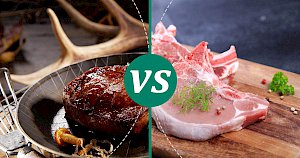Pork vs Venison (Deer Meat): Nutrition & Calories Compare


Pork vs Venison
Nutrition Facts
Serving size:
change
5g10g15g20g30g40g50g60g80g100g120g140g160g180g200g220g250g300g350g400g450g500g600g700g800g900g1000g
1oz2oz3oz4oz5oz6oz7oz8oz10oz12oz15oz20oz25oz30oz35oz40oz50oz
Amount Per Serving:
Serving size:
change
5g10g15g20g30g40g50g60g80g100g120g140g160g180g200g220g250g300g350g400g450g500g600g700g800g900g1000g
1oz2oz3oz4oz5oz6oz7oz8oz10oz12oz15oz20oz25oz30oz35oz40oz50oz
Amount Per Serving:
Pork vs Venison 100g Compare
| per 100g | Pork | Venison (deer meat) |
|---|---|---|
| Calories | 242 | 190 |
| Fat | 13.92 g | 3.93 g |
| Protein | 27.32 g | 36.08 g |
| Water | 57.87 g | 59.45 g |
| Calcium | 19 mg | 6 mg |
| Iron | 0.87 mg | 4.98 mg |
| Magnessium | 28 mg | 28 mg |
| Potassium | 423 mg | 311 mg |
| Sodium | 62 mg | 268 mg |
| Vitaminium B1 (Thiamine) | 0.877 mg | 0.152 mg |
| Vitaminium B2 (riboflavin) | 0.321 mg | 0.653 mg |
| Vitaminium B3 (Niacin) | 5.037 mg | 7.389 mg |
| Vitaminium B6 | 0.464 mg | 0.478 mg |
| Vitaminium B9 (Folic acid) | 0.005 mg | 0.011 mg |
| Vitaminium E | 0.29 mg | 0.75 mg |
When it comes to choosing between pork and venison, it's not just about taste; it's also about health benefits, nutritional content, and even environmental impact. Both meats are popular choices around the world, each bringing its own unique flavors and benefits to the table. Let's delve deeper into what sets these two meats apart, beyond just their calorie count.
Unveiling the Nutritional Secrets of Pork and Venison
At first glance, the nutritional content of pork and venison reveals some striking differences. With 242 calories per 100 grams, pork is higher in energy than venison, which has only 190 calories for the same amount. This difference is primarily due to the fat content; pork has 13.92 grams of fat, while venison is much leaner with just 3.93 grams.
However, venison leads the race in protein content, boasting 36.08 grams compared to pork's 27.32 grams. This makes venison an excellent choice for those looking to increase their protein intake without the added fat.
Both meats have zero carbohydrates, fiber, and sugar, making them suitable for low-carb and ketogenic diets. When it comes to micronutrients, venison shines with its high iron content of 4.98 mg, significantly more than pork's 0.87 mg. This makes venison an excellent choice for preventing iron deficiency anemia.
The Taste and Culinary Uses
The taste of pork and venison can be quite different, which often influences their use in recipes. Pork is known for its mild, versatile flavor that pairs well with a variety of seasonings and cooking methods. From slow-cooked pulled pork to grilled pork chops, its adaptability is unmatched.
Venison, on the other hand, has a rich, gamey flavor that is a result of the deer's diet. It tends to be more popular in dishes that can handle its strong taste, such as stews and game pies. Venison's lean nature requires careful cooking to avoid toughness, often benefiting from slow cooking methods to preserve its tenderness.
Environmental Impact and Sustainability
When considering the environmental impact, venison typically has a lower carbon footprint than pork. Wild deer need no farming inputs such as feed or water, making venison a more sustainable choice for environmentally conscious consumers. However, it's important to consider the source of venison, as overhunting can lead to ecological imbalances.
Pork, being a staple in many diets, is produced on a large scale, which often leads to concerns about animal welfare, antibiotic use, and the environmental impact of pig farming. Choosing pork from local, sustainable farms can mitigate some of these issues.
Health Implications
For those monitoring their cholesterol intake, it's worth noting that venison has a higher cholesterol content (112 mg) than pork (80 mg). However, the overall leaner profile of venison, coupled with its higher protein and lower fat content, still makes it a heart-healthy option.
Both meats provide essential vitamins and minerals, but venison slightly edges out with higher levels of vitamin B2, B3, and E, contributing to energy production, skin health, and protection against oxidative stress.
Final Thoughts
Choosing between pork and venison depends on personal preference, dietary goals, and environmental considerations. Venison offers a leaner, protein-rich option with a distinct flavor and lower environmental impact, making it appealing to health-conscious and eco-friendly consumers. Pork, with its versatility and milder taste, remains a popular choice for a wide range of dishes.
Ultimately, incorporating a variety of meats into your diet can provide a broad spectrum of nutrients and flavors, enriching your culinary experience while supporting your health goals.
Pork 100g
242kcalCalories source
- 0% CARBS.
- 47% PROTEIN
- 53% FAT
Venison (deer meat) 100g
190kcalCalories source
- 0% CARBS
- 80% PROTEIN
- 20% FAT
Compares of pork
- Pork vs Chicken Breast
- Pork vs Duck Meat
- Pork vs Luncheon Meat
- Pork vs Veal
- Pork vs Rabbit
- Pork vs Beef Jerky
- see all compares of pork
Marcin Piotrowicz
calories-info.com creator
Healthy diet and healthy lifestyle promoter
Add comment